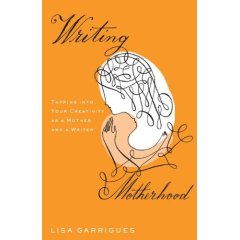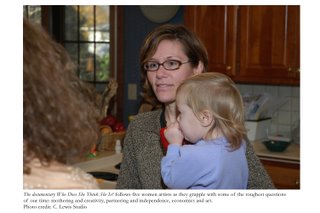
Very early on the morning of July 4th, 2001, I climbed out of bed and took a pregnancy test. As I waited for the result, I left the stick resting on the edge of the bathroom sink and sat down at my desk to write a few lines on my computer. A few minutes later, I went back and added some more thoughts, trying to absorb the fact that I was pregnant.
That was the start of my mothering journal.
I’d kept journals sporadically in the past: a small, cream- colored book my aunt gave me before a high school month in England; a cloth-bound book I bought before my junior year at Oxford University. But when I didn’t have a discrete period of time to document, I could never keep a journal going. I’d get fed up with myself for using it as a dumping ground for my complaints about adolescent life, or I’d get hung up with worry about someone finding it.
But this time was different. I’d just started a new job, I was pregnant, Tony and I bought a house: my life was changing fast, changing permanently, and I wanted to keep track of my thoughts.
That January, my computer crashed and took my journal with it. I lost teaching notes, syllabi, years’ worth of emails, but it was the journal’s loss that made me cry. It took me a few days to regain perspective (I hadn’t lost the baby, I kept having to remind myself, only the writing about the baby), but when I did, I took myself to a good art supply store and bought a nice journal with lined pages and an elastic strap to keep it closed.
And now I have a neat pile of six on the bottom shelf of my bedside table, with the current one, a pen in the middle holding my place, on the top shelf next to my lip balm, the current New Yorker, and a water glass.
I’ve kept it going.
The problem, though, was that before long the journal was not enough. I’d start something, jot down a funny thing Ben did or make an observation about my new life, and then it would sit there, undeveloped. I didn’t have any compelling reason to develop my thoughts into an essay. And after years of steady writing in graduate school, culminating in a nearly 300-page dissertation, I didn’t really even know how to write an essay about myself. I cast about for a year or so, writing unfinished essays during Ben’s naps, not knowing what to do with them. Eventually I lucked into a writing group and from there landed a position at Literary Mama and, between the gentle pressure of my monthly turn to present at writing group and the inspiration of the essays I edit, I found my way to a regular writing gig, a book, and a new life as a writer.
But it all would have been much simpler if I’d had Lisa Garrigues book, Writing Motherhood, back then.
I confess, I haven’t read any other writing books, so I have nothing to compare this to. Well, that’s not even quite right; I haven’t finished any other writing books. I’ve poked around Bird by Bird (and found it quite useful when I do), read a few lines of Writing Down the Bones, but I’ve always gotten a little impatient with the books, always had a moment when I realized, “Wait… no one’s asking me for snack, no one needs a dry diaper, I should be writing!” and put them down. So one of the things I like most about Garrigues’ book is that she invites you to do just that. It is not a book to read cover to cover (although I did, for this review, and it holds up perfectly well to that sustained attention), but one to pick up and read for twenty minutes when you have an hour free, or five minutes when you have ten: pick it up, find your inspiration, put the book down, and write. Because just as no one learns to parent by reading parenting books, no one learns to write without writing.
I like the bold orange cover of this book, which won’t get lost on my desk; that bright flash will always peek out from under the messy pile of drafts, bills, and Ben’s latest train drawings, and remind me to write. I like her tone, which is encouraging and friendly throughout; she leaves behind any kind of authoritative teacher voice and comes across as a woman you’d happily share a coffee with. Garrigues calls her writing prompts “invitations,” another subtle way that she manages to lighten up the task of setting down to write. And I like that she gives you lots and lots of good stuff to read, because the most important work in becoming a writer, after writing, is, of course, reading. Garrigues gives you her own short essays (on topics ranging from copying other writers, to marriage, to mama playdates); some of the little essays are hardly about writing at all, but about mothering, and then as she comes to the end and crystallizes the feeling that she’s expressed in the essay, she neatly raises a question for your own writing. She provides sample “mother’s pages” (essays written by her students), and she offers loads of great quotations from other writers. She also offers concrete advice on everything from buying a writer’s notebook to setting up a productive workspace. I have both of those things, but I still picked up a couple good ideas from her. She closes the book with an entire section on moving from new writer to a writer seeking connection and publication, with ideas on setting up and maintaining writing groups and taking one’s writing public. And then, in case there weren’t already enough ideas to keep you going in the text of the book, she offers a list of 99 writing starts and a bibliography.
I am keeping this review short because, inspired by Garrigues book, I want to get back to my writing! But I want to leave you with a couple quotations. The first, from Annie Dillard, resonated with me right now as I struggle to clear space in my days to write:
How we spend our days is, of course, how we spend our lives. What we do with this hour, and that one, is what we are doing. A schedule defends from chaos and whim. It is a net for catching days.
And now here’s Garrigues:
This book is, in part, a story of growing up and into a role I claimed for myself.
Is she talking about mothering or writing?! The point, as she claims throughout the book, is that the two are not mutually exclusive but complimentary roles that feed and develop each other. We should take advantage of that fact, and make time to write our lives.
Garrigues teaches writing classes, and those of you in the NY/NJ area should check them out. For anyone looking for on-line writing classes, I highly recommend Susan Ito’s parent lit workshop (which I have taken) and the new poetry workshop led by Violeta Garcia-Mendoza (my editorial assistant in Literary Reflections). Literary Mama will soon be offering monthly writing prompts, with personal feedback from th
e Literary Reflections editorial staff, as well as listings of workshops and other resources for writers. Get writing!









